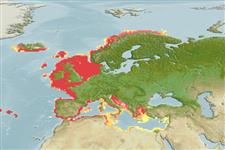Common names from other countries
Environment: milieu / climate zone / depth range / distribution range
экология
; пределы глубины 9 - 200 m (Ref. 2754). Subtropical
Northeast Atlantic and the Mediterranean.
Length at first maturity / Size / Вес / Возраст
Maturity: Lm ? range ? - ? cm Max length : 7.5 cm SHL самец/пол неопределен; (Ref. 2759)
White to light yellow shell exterior with occasional dark markings; smooth shell surface; valves with 40 to 50 non-projecting or faint ribs around the center; crenulated shell margin.
Minimum depth based from occurrence (Ref. 2742); to be replaced with a better reference. Collected from the sublittoral zone, from low tide up to a depth of 200 m. It is found in substratum with generally coarse sand and gravel, often overlain with pebbles, cobbles and dead shell (Ref. 2742 and 2744). It's a sessile-burrower, suspension feeder (Ref. 96498).
Life cycle and mating behavior
половая зрелость | размножение | нерест | икра | Fecundity | личинки
Members of the class Bivalvia are mostly gonochoric, some are protandric hermaphrodites. Life cycle: Embryos develop into free-swimming trocophore larvae, succeeded by the bivalve veliger, resembling a miniature clam.
Основная ссылка
ссылки | координатор | соавторы
Demir, M. 2003. (Ref. 2754)
Статус Красного Списка МСОП (Ref. 130435)
Статус СИТЕС (Ref. 108899)
Not Evaluated
Not Evaluated
Использование человеком
рыболовство: коммерческий
| FishSource | Sea Around Us
инструменты
дополнительная информация
ресурсы в Интернет
Estimates based on models
Preferred temperature
(Ref.
115969): 6.9 - 16.3, mean 10 (based on 530 cells).
Уязвимость
Low vulnerability (10 of 100).
